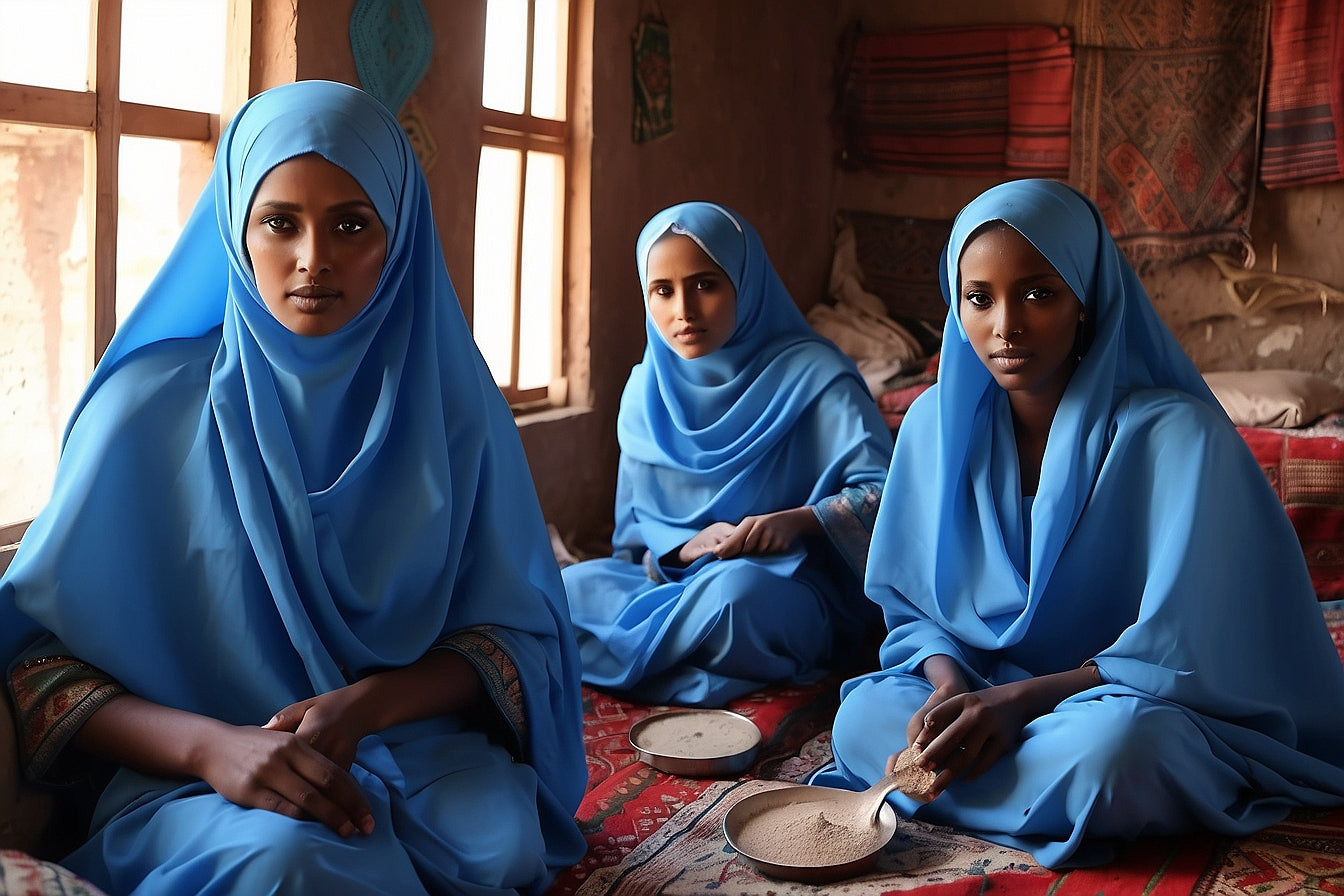All about Somalia's Gob Tree
If you’re reading this article, then the likelihood is that you’re already aware of and love qasil powder and its amazing skin-clearing properties. What we once called ‘nature’s best kept secret,’ has now left the shores of Somalia to become a cult favourite in beauty routines all over the world. While the transformation of your skin is testament enough to the benefits of using qasil, you may be asking yourself what exactly is in this inconspicuous green powder that gives it all of its healing qualities.
We’ve broken it down for all of you qasil aficionados!
What is Qasil?
Qasil is the Somali name by which this potent green powder is now most commonly known. If we were botanists or biologists, we’d refer to it as Ziziphus Jujube powder, which comes from the Ziziphus Spina-Christi tree (or the gob tree as it's called in Somalia). It belongs to the buckhorn family (Rhamnaceae, if you want to be specific). Although this family of trees can be found all over the world, the gob tree is native to both South Asia and North Africa. It produces drupes (sweet and fleshy fruits with a single stone resembling dates).
In Somalia, however, qasil is considered the true jewel of the gob tree.
So, what part of the tree does the qasil come from? It’s from the leaves, which are sun-dried and crushed into this fine green powder that has been used for centuries by Somali women.
What is the etymology of the Gob tree’s name?
To answer this question, we need to give you a brief rundown of the historical significance of this particular tree species. In both the Christian and Muslim traditions, this tree is considered an emblem of holiness.
In the Quran, it is prized for its robust and resilient structure, and its ability to bear delicious fruits and honey with great medicinal properties. In Arabic speaking countries, the tree is often referred to as sidr or tsal, while its fruit is known as nabaq. In fact, if you’ve ever heard of sidr honey in any health journal as being one of the most antioxidant and antimicrobial rich natural substances in the world, just know that it is harvested from this very tree. It’s also super delicious, but don’t just take our word for it - wait until you taste it yourself!
In Christianity, the Ziziphus tree is associated with the thorn bush that Jesus was crowned with before his crucifixion. Hence, the root of its scientific name today - spina-christi - meaning Christ’s thorn. So treasured is the Ziziphus spina-christi, that people on religious pilgrimages will collect the branches and take them back to their homelands as devotional symbols.
Now, the name gob by which we refer to the tree is its Somali name. Although its exact definition is disputed, it is thought to mean ‘good,’ ‘trustworthy,’ and ‘reliable.’ We would argue that these three words perfectly encapsulate the qualities not only of the tree, but of all the wonderful fruits and plants that it bears.
What makes the gob tree so unique?
The gob tree is unique for its ability to adapt and thrive in dry climates. Despite enjoying a vast coastline, Somalia’s climate is dry and often fraught with drought. The gob’s rich carbohydrate reserves give it outstanding regenerative potential, meaning its ability to recover from injury (and even fire) is second-to-none. Often, in the midst of drought and wildfires, the gob tree shows remarkable resilience. Though undoubtedly damaged, the gob’s presence in such areas is never fully eliminated, and in many cases, it does eventually grow back. Native Somalis frequently use the branches from the gob to create houses for themselves and their families. It is no surprise, then, that Somalis called it the gob tree; a word associated with trustworthiness and reliability. Despite the ongoing climate emergency in Somalia, the widespread presence of the gob tree represents hope. Where there is a gob tree, there is a potential for the creation of shelter, even if circumstances mean it’s only temporary.
What are some of the properties of the fruit the gob tree produces?
As we mentioned earlier, the gob tree produces fruit known scientifically as drupes. These fruits, however, are most commonly known as jujubes. While they are just as sweet as their date counterparts, they differ considerably in taste. More conventional dates resemble a caramel or burnt sugar flavour, while the gob’s jujubes are unique for having more of a botanical flavour, resembling raw honey. These fruits are usually consumed raw, although they are sometimes dried and ground into a powder that is steamed and rolled into ball shapes resembling cake-pop style desserts.
What’s even more remarkable about this fruit is its nutrient-rich chemical composition. Its sweetness is a tell-tale sign of its high levels of healthy carbohydrates. Carbohydrates represent over 80% of the fruit’s total matter. Forget about oranges - the jujube’s ascorbic acid (vitamin c) content is something to write home about! The jujube fruit has 98mg to the orange’s 50mg, making it a great source of antioxidants (see our article on the benefits of vitamin c).
If you thought the list stopped here, you’re absolutely wrong! The fruit is full of amino acids that support muscle growth and tissue strength. The fruit is chock-full of essential fatty acids. In particular, the presence of linoleic acid plays a special role in supporting heart health, as it reduces cholesterol and improves blood pressure. Its high calcium and magnesium content supports healthy bones and reduces inflammation caused by other foods and exercise.
Although we are lucky in our modern era to have access to such a concrete breakdown of data, the medicinal benefits of the gob tree’s fruit have been known and respected for centuries. This is not because ancient civilisations knew the exact percentages of all the nutrients and vitamins inside of the fruits, but because they saw with their own eyes how it healed people’s ailments. The fruit has been used to alleviate the inflammation and pain caused by rheumatism and to heal wounds and superficial swelling. The gob tree’s fruit was also believed to provide relief from headaches and heartburn and even settle an upset stomach.
The future of the gob tree
You may ask yourself what we mean by the future. We think the gob tree is truly magical - not just because it allows us to harvest the qasil powder that we so love to share with all of you, but because of all of the other wonderful properties its fruit holds, and what the tree symbolises to so many people across the world.
As we have explained, the gob tree is strong and adaptable, even in some of the harshest environmental conditions in the world. However, we can no longer rely solely on the faith that the gob tree will be able to overcome any climate obstacle that comes its way. As we are sure you are aware, these are unprecedented times: the ice caps are melting, the Amazon rainforest is a shadow of its former self, C02 levels are rising, and wildfires are raging. We could go on…
Although news outlets often neglect to talk about the effects of climate change in Somalia, it is not an exaggeration to claim that the country is in the middle of a climate emergency. Severe drought has brought with it the death of livestock and crops, leading to the displacement of an estimated 370,000 people in 2019 alone. With such huge numbers of climate migration has come poverty, hunger and death.
Our company was created in 2017 with a twofold vision: to introduce qasil to the world, but also to use it as a vehicle for social reform back in Somalia. By growing our platform, we hope to expand our conservation work in Somalia. We are working with environmental consultants and organisations this year to begin work on our ‘plant a tree initiative’ that aims not only to look after the area where our qasil is harvested but expand into reforesting areas that have been affected by climate change. This, we hope, will not only support the local environment but provide more economic opportunities for the locals, which have been the victims of continual displacement.
We want to thank all of you that have donated so far and all of you that will donate in the future. For those of you that are not in a position to donate, know that you are just as valued for taking the time to gain awareness and knowledge on this issue.




2 comments
as someone i who is proud somali, im not for the exploitation of our prized possessions. i understand the need to sell and broadcast but some merchandises are rare and should remain sacred. its only a matter of time western society will appropriate our own resources. please think about it. just some feedback to ponder on. also the information needs to be updated; not all the way accurate. iA khair. JAK
I want to order your products by the name Qasil
How much? and how do l pay
How long is it going to take to reach me?